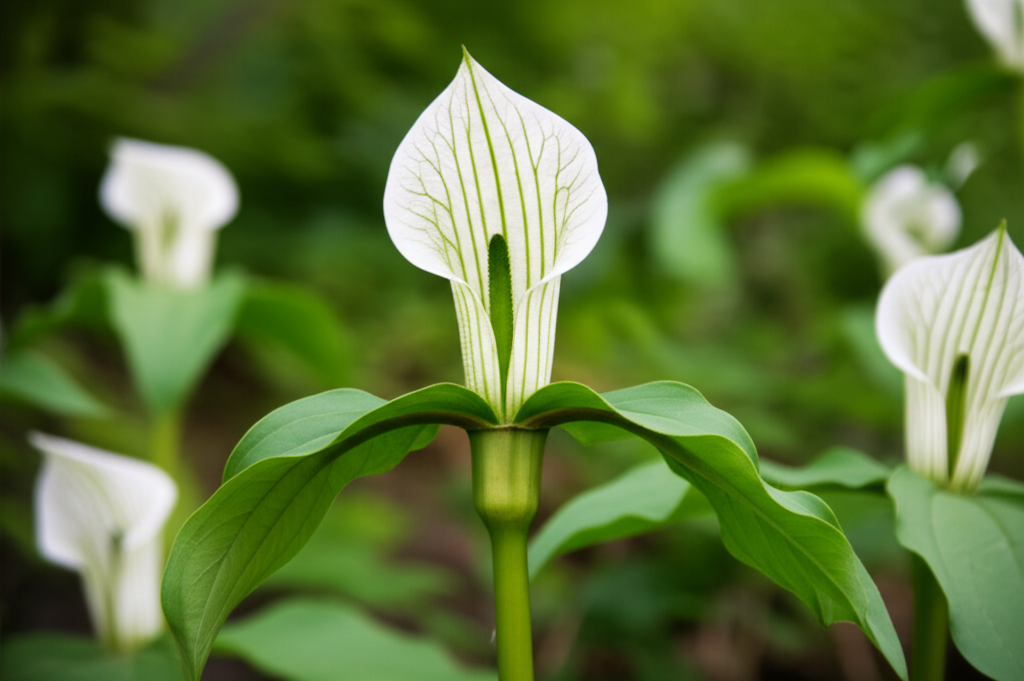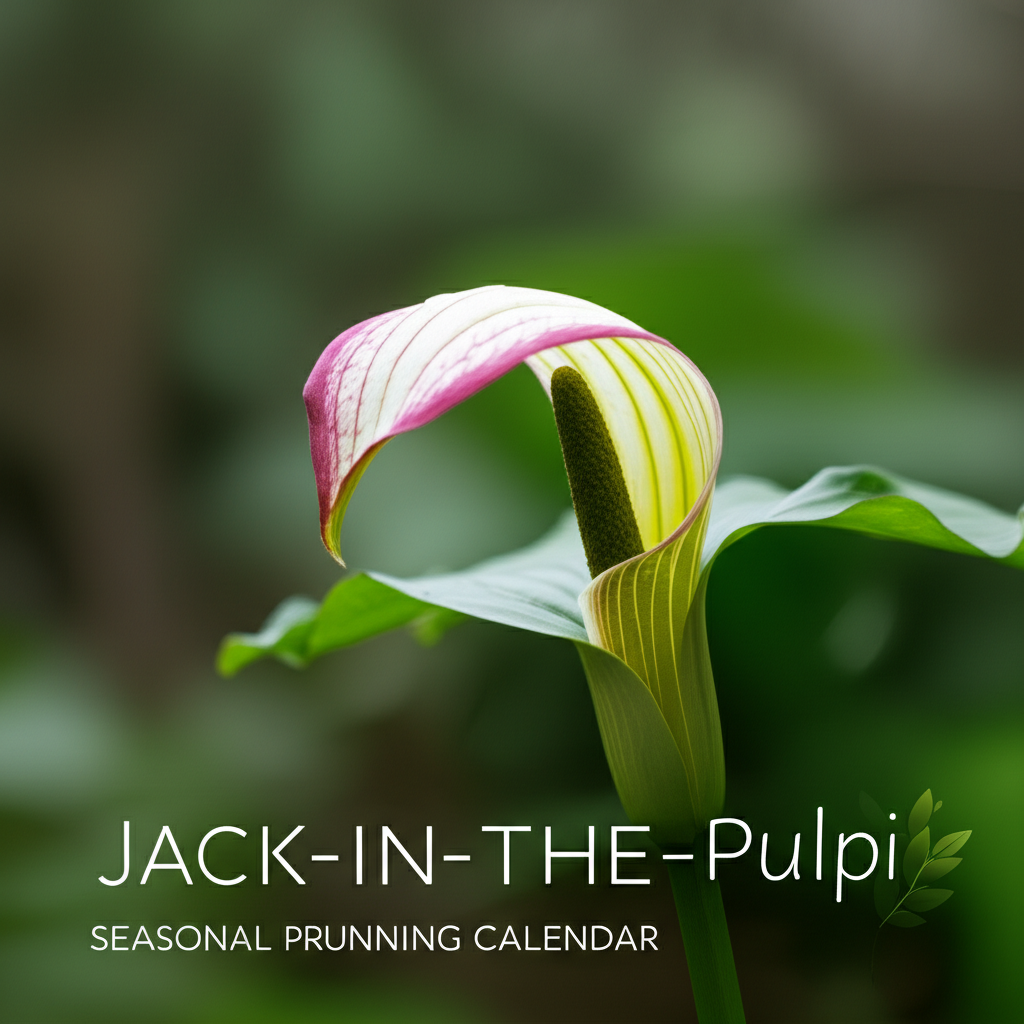Introduction to Jack-in-the-Pulpit
The Jack-in-the-Pulpit (Arisaema triphyllum) is a captivating native woodland perennial that adds a touch of the exotic to shady garden corners. Its unique spathe and spadix structure, resembling a preacher in a pulpit, earns it its common name and sparks curiosity among gardeners. Thriving in moist, humus-rich soils and partial to deep shade, this plant is a cornerstone of many woodland gardens and naturalistic landscapes. While often admired for its striking spring bloom, understanding its seasonal needs, particularly pruning, is crucial for its long-term health and vigorous growth. This comprehensive guide will walk you through a year-round pruning and care calendar, ensuring your Jack-in-the-Pulpit flourishes.
Understanding Jack-in-the-Pulpit’s Life Cycle

Before delving into pruning, it’s essential to grasp the plant’s life cycle. Jack-in-the-Pulpit is a deciduous perennial, meaning it dies back to the ground each year. It emerges in early spring, sending up its characteristic hooded flower. After flowering, it produces a cluster of red berries in late summer or early fall, a vital food source for wildlife. The foliage then senesces, or yellows and dies back, as the plant prepares for dormancy. This cyclical nature dictates when and how we should approach pruning and care.
Seasonal Pruning and Care Calendar
Pruning for Jack-in-the-Pulpit is generally minimal and focused on maintaining health and tidiness rather than aggressive shaping. The key is to work with the plant’s natural growth patterns.
Spring: Emergence and Early Growth
Spring is an exciting time as the first shoots of Jack-in-the-Pulpit emerge from the soil. This is when vigilance for potential issues begins.
- Observation: The primary “pruning” in early spring is observational. Look for any signs of winter damage, such as broken stems or leaves that were damaged by frost.
- Gentle Removal: If you find any damaged foliage, gently snip it away with clean, sharp pruners or scissors. The goal is to remove unsightly parts without disturbing the emerging growth.
- Pest and Disease Checks: While not strictly pruning, early spring is the ideal time to inspect for any signs of slugs, snails, or fungal diseases that might have overwintered. Prompt removal of affected parts can prevent widespread issues.
- Weed Control: Keep the area around your Jack-in-the-Pulpit free of competing weeds, which can steal precious nutrients and moisture. Gentle hand-pulling is best to avoid damaging the shallow root system.
Late Spring to Early Summer: Flowering and Fruiting
This is the peak of Jack-in-the-Pulpit’s aesthetic appeal, with its unique inflorescence on full display. Pruning at this stage is almost non-existent, focusing instead on appreciating the plant.
- Do Not Prune Flower Stalks: Resist the urge to cut back the flower stalk unless it is severely damaged. The spathe and spadix are the plant’s main attraction during this period.
- Patience with Fruiting: After flowering, the plant will develop a cluster of berries. These are a valuable food source for birds and other wildlife, so it’s best to leave them intact as long as possible.
- Watering: Ensure consistent moisture, especially during dry spells. Jack-in-the-Pulpit prefers damp conditions.
Summer: Maturation and Dormancy Preparation
As summer progresses, the leaves will begin to naturally yellow and may start to die back, especially if the soil dries out. The berries will ripen to a vibrant red.
- Allow Foliage to Yellow: Do not cut back the foliage prematurely, even if it starts to yellow. The leaves are still photosynthesizing and sending energy down to the corm (the underground storage organ). Cutting them back too early will weaken the plant for the following year.
- Berry Removal (Optional): If you wish to collect seeds for propagation, you can carefully remove the berry clusters once they are fully ripe. However, for wildlife benefit, it’s recommended to leave them.
- Watering Continues: Continue to provide adequate water, especially if rainfall is insufficient, to support the plant’s energy reserves for dormancy.
Late Summer to Fall: Dieback and Seed Dispersal
This is the period when the plant naturally recedes. The leaves will have turned yellow and fallen over, and the berries will have likely been eaten by wildlife.
- Wait for Complete Dieback: The most crucial “pruning” step for Jack-in-the-Pulpit is to wait until the foliage has completely died back and turned brown or black. This indicates that the plant has successfully transferred all necessary nutrients to its corm.
- Minimal Trimming: Once the foliage is fully dead, you can trim away the dead stalks and leaves close to the ground. This tidies up the garden bed and prevents potential disease from lingering on decaying matter. Use clean, sharp pruners.
- Mulching: Apply a layer of organic mulch (such as shredded leaves, compost, or pine needles) around the base of the plant. This helps to insulate the corm, retain moisture, and suppress weeds.
Winter: Dormancy
The Jack-in-the-Pulpit is fully dormant during winter. Its underground corm is the only active part, storing energy for the next growing season.
- No Pruning Required: There is no pruning to be done during winter. The dead foliage should have been cleared in the fall.
- Soil Protection: The mulch applied in the fall will continue to protect the soil and the dormant corm from extreme temperature fluctuations.
- Planning: This is a good time to plan for any new plantings or to consider where you might want to expand your Jack-in-the-Pulpit collection.
Key Considerations for Jack-in-the-Pulpit Care
Beyond seasonal pruning, several other factors contribute to a thriving Jack-in-the-Pulpit:
- Soil: Rich, moist, well-drained soil is paramount. Amend heavy clay soils with compost to improve drainage and aeration.
- Light: Partial to deep shade is ideal. Avoid direct afternoon sun, which can scorch the leaves.
- Moisture: Jack-in-the-Pulpit thrives in consistently moist conditions. It can tolerate occasional dampness but dislikes waterlogged soil.
- Division: Mature plants may form clumps and can be divided during their dormant period (late fall to early spring) if they become overcrowded or if you wish to propagate them. Gently separate the corms and replant them at the same depth.
Key Facts and Comparison
To better understand the care requirements, let’s compare Jack-in-the-Pulpit to other common shade-loving perennials:
| Feature | Jack-in-the-Pulpit (Arisaema triphyllum) | Hostas | Ferns (e.g., Ostrich Fern) | Astilbe |
|---|---|---|---|---|
| Sunlight Needs | Partial to deep shade | Partial to full shade; some tolerate morning sun | Partial to deep shade | Partial shade to full sun (with consistent moisture) |
| Soil Preference | Moist, humus-rich, well-drained | Rich, well-drained | Moist, humus-rich | Moist, well-drained, rich |
| Pruning Focus | Removal of dead foliage in fall; minimal intervention during growth | Removal of damaged leaves; deadheading spent flowers (optional for seed) | Minimal; removal of dead fronds in fall/winter | Deadheading spent flowers; cutting back foliage in fall |
| Watering Needs | Consistently moist | Moderate; prefers consistent moisture | Consistently moist | High; requires consistent moisture |
| Unique Feature | Striking hooded flower, attractive berries | Varied foliage textures and colors | Lacy, architectural fronds | Plumes of colorful flowers |
Pruning Steps and Considerations: A Practical Approach
Here’s a breakdown of the practical steps involved in pruning and caring for Jack-in-the-Pulpit throughout the year, along with the pros and cons of different approaches.
| Season | Action | Pros | Cons |
|---|---|---|---|
| Spring | Inspect for damage, gently remove broken/frost-damaged leaves. | Promotes healthy new growth, prevents disease spread, improves appearance. | Requires careful observation to avoid damaging new shoots. |
| Monitor for pests (slugs, snails). | Early detection and removal prevent significant damage. | Can be time-consuming; requires knowledge of common pests. | |
| Late Spring / Early Summer | Allow flowering and fruiting structures to remain. | Enjoy the unique bloom; provides food for wildlife. | No structural pruning possible; plant is in its most sensitive phase. |
| Ensure adequate moisture. | Supports plant health and bloom production. | May require supplemental watering during dry periods. | |
| Summer | Allow foliage to naturally yellow and die back. | Ensures energy reserves are fully replenished in the corm for next season. | Plant may appear less tidy as foliage declines; requires patience. |
| Late Summer / Fall | Wait for complete foliage dieback before cutting. | Maximizes energy storage, prevents weakening of the plant. | Requires delaying tidying until the very end of the season. |
| Trim dead foliage close to the ground. | Tidies garden beds, reduces overwintering sites for pests/diseases. | Must use clean tools to avoid introducing pathogens. | |
| Fall | Apply organic mulch. | Insulates corm, retains moisture, suppresses weeds, enriches soil. | Can slightly delay spring emergence if mulch is too deep. |
| Winter | No pruning; allow dormancy. | Plant regenerates underground; essential for survival. | No active care needed, but can miss opportunities for observation. |
Troubleshooting Common Issues
While generally robust, Jack-in-the-Pulpit can encounter a few problems:
- Leaf Spot/Fungal Diseases: Ensure good air circulation and avoid overhead watering late in the day. Remove infected leaves promptly in spring or fall.
- Slugs and Snails: These are the most common pests. Use barriers, baits, or manual removal. Healthy plants with robust corms are more resilient.
- Poor Blooming: This can be due to insufficient light, poor soil conditions, or cutting back the foliage too early in the previous season. Ensure the plant has adequate time to store energy.
- Drying Out: If the soil consistently dries out, the plant may enter dormancy prematurely or fail to thrive. Consistent moisture is key.
When to Divide Jack-in-the-Pulpit
Dividing Jack-in-the-Pulpit is not a pruning activity but a method of propagation and rejuvenation. It is best performed during the dormant season, which is generally late fall after the foliage has died back, or very early spring before new growth emerges.
- Locate the Corm: Gently excavate around the plant to expose the corm. Be careful not to damage it.
- Identify Divisions: Mature corms often produce offsets or smaller corms attached.
- Separate: Use a clean, sharp knife or trowel to carefully separate the larger corm from its offsets. Ensure each division has at least one bud or growing point.
- Replant: Replant the divisions at the same depth they were previously growing, typically 2-4 inches deep, in well-prepared soil.
- Water and Mulch: Water thoroughly after replanting and apply a layer of mulch.
Conclusion
Pruning Jack-in-the-Pulpit is a far simpler task than with many other garden plants. It’s primarily about observation, timely removal of genuinely dead or damaged material, and, most importantly, allowing the plant to complete its natural life cycle without interference. By following this seasonal calendar and understanding the plant’s needs, you can ensure your Jack-in-the-Pulpit remains a healthy, fascinating, and enduring presence in your woodland garden for years to come.


